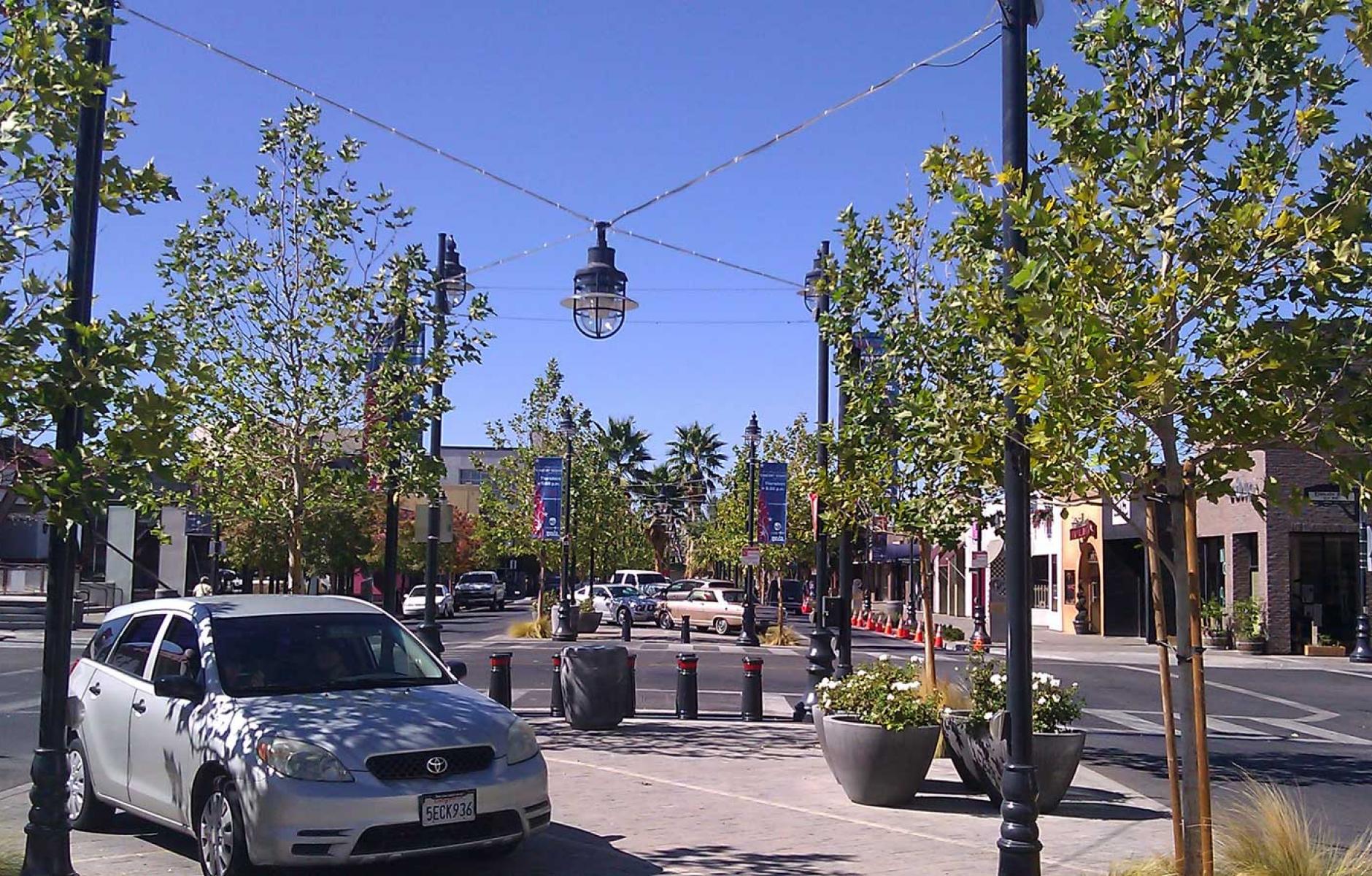
From car-oriented thoroughfare to community center
Note: This case study was written for the Institute for Transportation Engineers new book Implementing Context Sensitive Design on Multimodal Corridors, funded by the Federal Highway Administration.
The nine-block makeover of Lancaster Boulevard, the city’s historic main street, has become a regional draw and attracted a surge of economic development since opening in 2010. Rebranded the BLVD, this thoroughfare’s features are unique among Complete Streets.
Up until the 1950s, Lancaster Boulevard was the main street of a small railroad settlement in the Antelope Valley, in northern Los Angeles County, east of the San Gabriel Mountains. In the last six decades, the town has grown to a sprawling city of 168,000 people, but the street, a principal arterial, suffered from increased and faster-paced traffic—and surface parking lots between buildings created gaps in the urban fabric.
“We knew that in order to revitalize the downtown, we had to reconsider the design of the street,” says city planning director Brian Ludicke. “This was a 40 to 50 mile per hour thoroughfare dividing downtown. It was dangerous, noisy, and pedestrians didn’t like to cross.”
Prior to the reconstruction, Lancaster Boulevard had five lanes of traffic and measured 72 feet from curb-to-curb, carrying 15,000 cars per day. The new design converts the three central lanes to a 32-foot-wide median, or “Ramblas,” lined with a double-row of shade trees, inspired by Barcelona, Spain’s world-famous Las Ramblas. The center of the BLVD is used for diagonal parking, adding about 100 spaces for downtown shoppers and visitors—while also providing ample room for people to get out of their cars and linger in small public spaces surrounded by rows of trees, lampposts, and large potted plants (see photo above) .
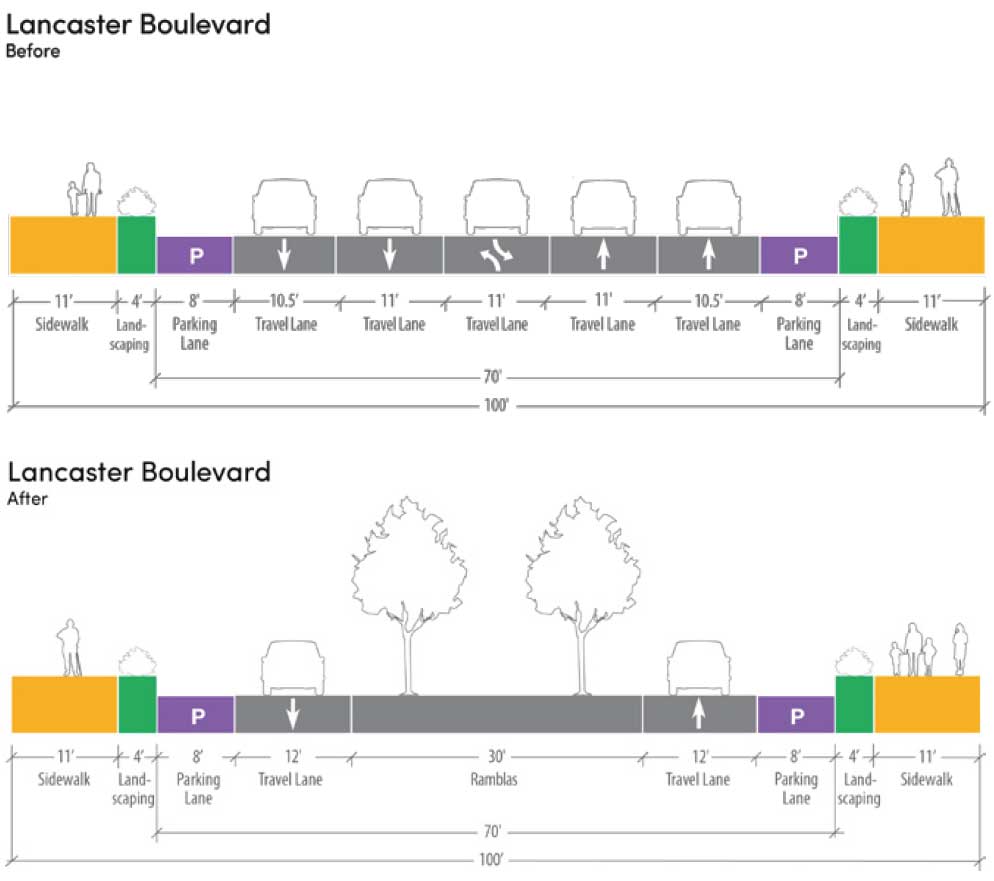
On both sides of the Ramblas, one 12-foot travel lane in each direction carries a total of 11,000 vehicles per day. A row of on-street parking separates the moving vehicles from improved sidewalks, street furniture, shopfronts, and buildings.
The speed limit has been reduced to 15 miles per hour from 35 miles per hour, reflecting the slower design speed. Traffic signals were removed along the corridor—replaced with stop signs on the cross streets—and motorists progress slowly, prepared to yield to pedestrians or other motorists backing out of parking spaces. “People stop for pedestrians and let them cross,” Ludicke says. “Drivers acknowledge pedestrians and pedestrians acknowledge drivers. People are forced to pay attention, which is why it’s a lot safer.”
The BLVD is designed for flexibility. For street fairs and markets, the angled parking of the Ramblas is converted to public space. For major festivals and parades, the travel lanes also are closed and made pedestrian only.
In the central block of the BLVD, the outside lanes of street parking have been eliminated to widen the sidewalk for outdoor café seating. “A number of restaurants and businesses have taken advantage of this opportunity for outdoor patios,” says Chenin Dow, of the city’s Economic Development department. “As the block also features a built-in stage on the southwest corner of Elm and the BLVD, this has become a natural gathering place and center of events.”
The Ramblas was meticulously designed to balance the needs of people, parking, trees, lighting, and other street furniture. A six-foot area between each diagonal parking space is reserved for people to move around and for the placement of trees and lampposts. The posts hold overhead wires that cross in a diamond pattern and support the lights. In the center of each block, a mid-block crossing and small public space with seating provides pedestrians with cross-street access and an area to relax. The Ramblas parking is angled at 40 degrees to allow motorists to back safely into the 12-foot travel lane. The Ramblas is built at street grade to allow for parking—but is delineated by pavers and vertical elements. The at-grade design is helpful during festivals.
Although the BLVD is able to store and move many cars, its primary purpose is a public space rather than a transportation corridor. Practitioners realized that the city had no “iconic public space element,” says Vinayak Bharne with Moule & Polyzoides, the lead architects. The desert downtown also desperately needed shade. “We realized that whatever we do, the design must provide shade and there must be something dramatic. It must be a big gesture—not something small.” That thinking led to inspiration from Barcelona, an approach that resonated with the city.
The most sophisticated aspect of the BLVD is not physical design—rather the city’s design of the process aimed at complete urban transformation, Bharne explains. “The real success of the transformation was based on an exceedingly intelligent downtown vision, a very tight budget that the practitioners respected, and a streamlined, synergistic process with the Council and the community to make sure that the boulevard was completed 100 percent on time,” he says.
Transit stops serving multiple routes are located at the east and west ends of the BLVD, but Antelope Valley Transit buses are routed around the central portion of the BLVD on parallel downtown streets. Trucks are allowed on the BLVD for local deliveries, but are not prioritized. Businesses generally have rear access from cross streets and/or alleys. The BLVD is posted as a bicycle route and the speed allows bicyclists to mingle with traffic.
Implementation
The city struck on the idea of transforming the main street through a downtown vision plan, completed in 2008. A few years prior to that, the city had adopted a form-based code for the downtown to ensure new development supports pedestrian activity.
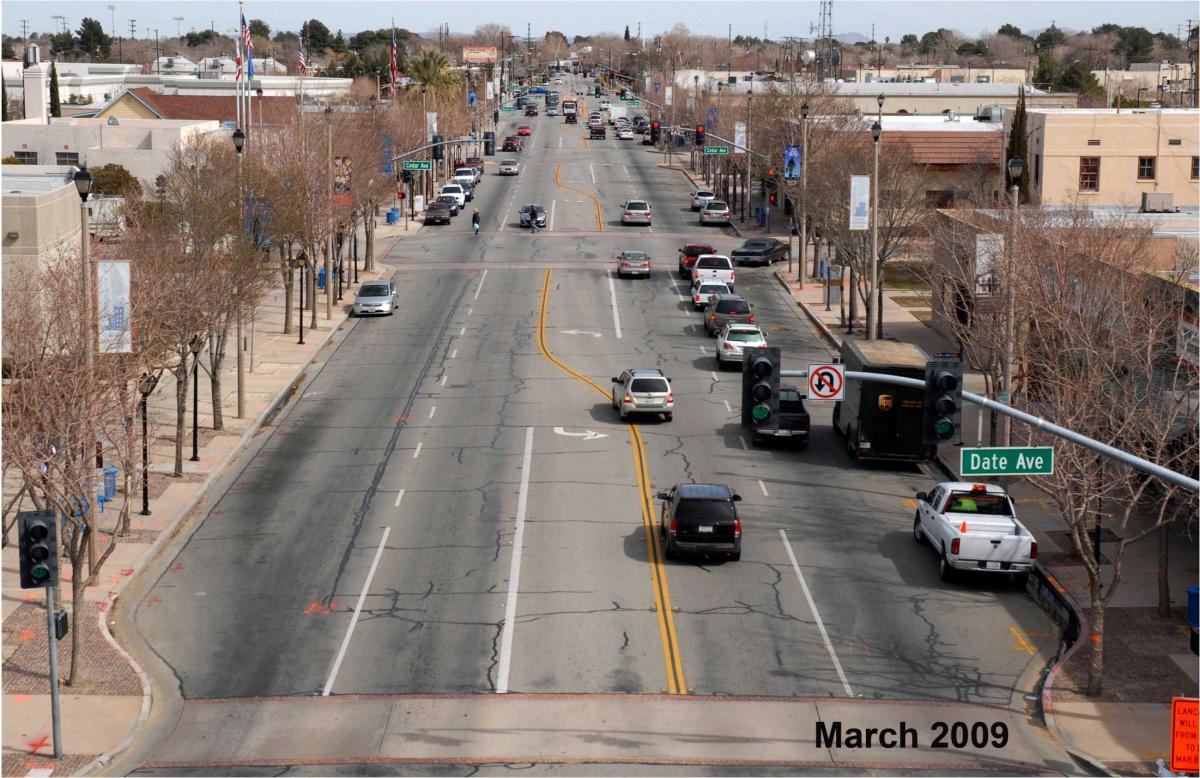
The money for thoroughfare redesign came through the local redevelopment agency, part of a system that was disbanded in 2012 due to a change in state policy. Talk of this disbandment caused the city to shift into high gear to protect its redevelopment funds.
The city conducted intensive public outreach. When talking with citizens and the business community, the officials did not seek agreement on everything. “We had to move quickly,” says Caudle. “We told them we are seeking input, not consensus, which is hard to build and difficult to achieve. The business people were generally supportive. There were some naysayers.”
The greatest concern came from citizens about removing traffic signals. “We could have taken the position that yes they are right, and no we don’t want to hear the complaints, and we will not be leaders or forward thinking,” says Caudle. “It would have been a less successful project. The willingness to do something different in street design had a direct impact on the success of the private investment.”
The city hired the practitioners who conducted a workshop and wrote a report with a detailed vision in 2009. During the planning phase, skepticism about the project was rampant, Caudle says. “It was going to be a great success or the biggest waste of money ever. I don’t think there was any in-between.”
As the construction documents were prepared, the city sought developers to seek a financial return from the investment. The city found a primary private sector partner, Scott Ehrlich of Insite Development, based in Los Angeles, who believed strongly in the vision. “He moved in quickly acquiring new property and remodeling it, expanding it to include housing, retail, entertainment—all of the things we were trying to achieve,” Caudle says. Other investors came forward, some in partnership with the city and some who worked independently.
“By the time the technical documents were finished, the boulevard project was ready to break ground,” Bharne says. “It received immediate Council approval. There was no delay in terms of budget, finance, process, or bureaucracy.” The speedy implementation was a necessity, says Caudle. “We had the money, so that wasn’t an issue. We had the community buy-in and council support. And the businesses wanted to get back open as soon as possible.” The city dedicated two-full staffers to work with businesses and deal with construction issues, working out of a temporary office on the boulevard. Within eight months of the final design, in 2010, the BLVD was built.
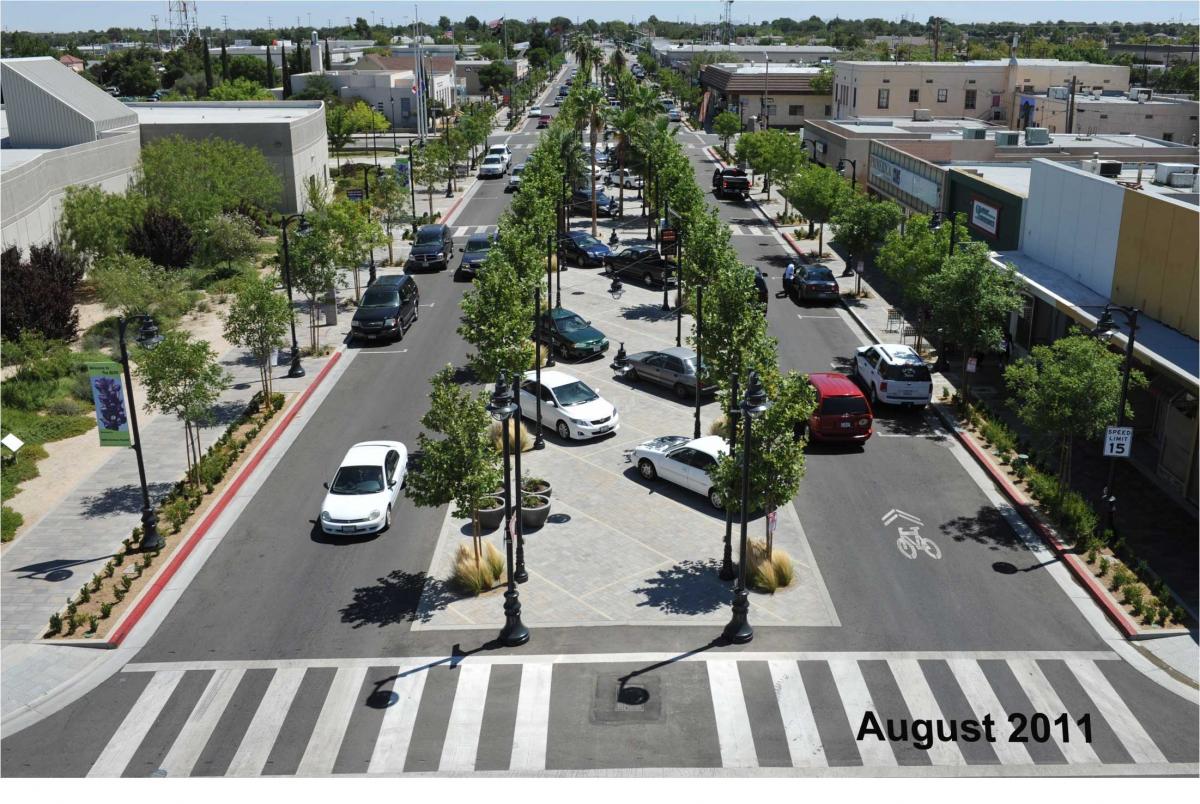
This $11.5 million project included streetscape costs—the street itself, center Ramblas parking/festival area, sidewalk with colored pavers, curb and gutter, trees, landscaping, lighting, removal of traffic signals, and street furniture. The redevelopment funds were available but limited, which forced specific design approaches, such as not “breaking the curb” in most of the corridor, notes Bharne.
The city took some unusual steps, such as designing and placing business kiosks for entrepreneurs. The city has set up 32 kiosk locations, many in the Ramblas, for rental at $500/ per month to start-up retail businesses that can’t afford brick-and-mortar storefronts. The goal is that some of these businesses eventually graduate to storefronts.
Results
Counts point to a doubling of pedestrians from just after completion in 2010 to 2016 on a typical weekday. Despite the greatly increased use of the corridor, injuries and crashes have dropped significantly. Total motor vehicle collisions are down 38 percent, and injury crashes have fallen by 49 percent—based on average numbers from 2011 to 2015. Pedestrian-involved collisions have plummeted by 78 percent.
The BLVD’s total economic impact was second highest out of 37 complete streets projects studied by Smart Growth America in 2015, “The real genius of Lancaster is in economic development,” says Bharne. “You can call it complete streets or whatever you want, but at the end of the day, the biggest contribution it made was the economic revitalization of the city.”
Since the BLVD construction, 57 new businesses have opened in downtown Lancaster. Retail sales have risen 57 percent from 2010 to 2016. More than 800 housing units have been built or refurbished, the vast majority affordable. Construction or rehabilitation of commercial space totals 177,000 square feet. Insite has built nine housing developments downtown and was a startup partner in a number of new businesses, including an underground bowling alley, a trendy restaurant called BeX, and a nightclub—the RoShamBo Lounge.
Commercial occupancy on the BLVD is now at 96 percent. Nearly 2,000 jobs have been created and the total economic impact is estimated at $282 million, based on a state formula.
A new art-house movie theater opened, in addition to a microbrewery, apparel stores like Urban Outfitters, and other shops and restaurants. The Lancaster Museum of Art & History also opened, which anchors one end of the boulevard. A pre-existing performing arts center anchors the other end.
Civic and social activity downtown has skyrocketed. Event attendance includes:
• Two thousand people visit a weekly summer farmer’s market with concert series, with about half that many come to the winter market.
• Major annual festivals—including Halloween & Harvest, Christmas, Celebrate America, and a go-cart Grand Prix—draw 20,000 to 35,000 attendees each.
• Other regular events, such as Terrific Tuesdays, Artwalk, and Dinner & A Movie, draw Lancaster residents downtown year-round.
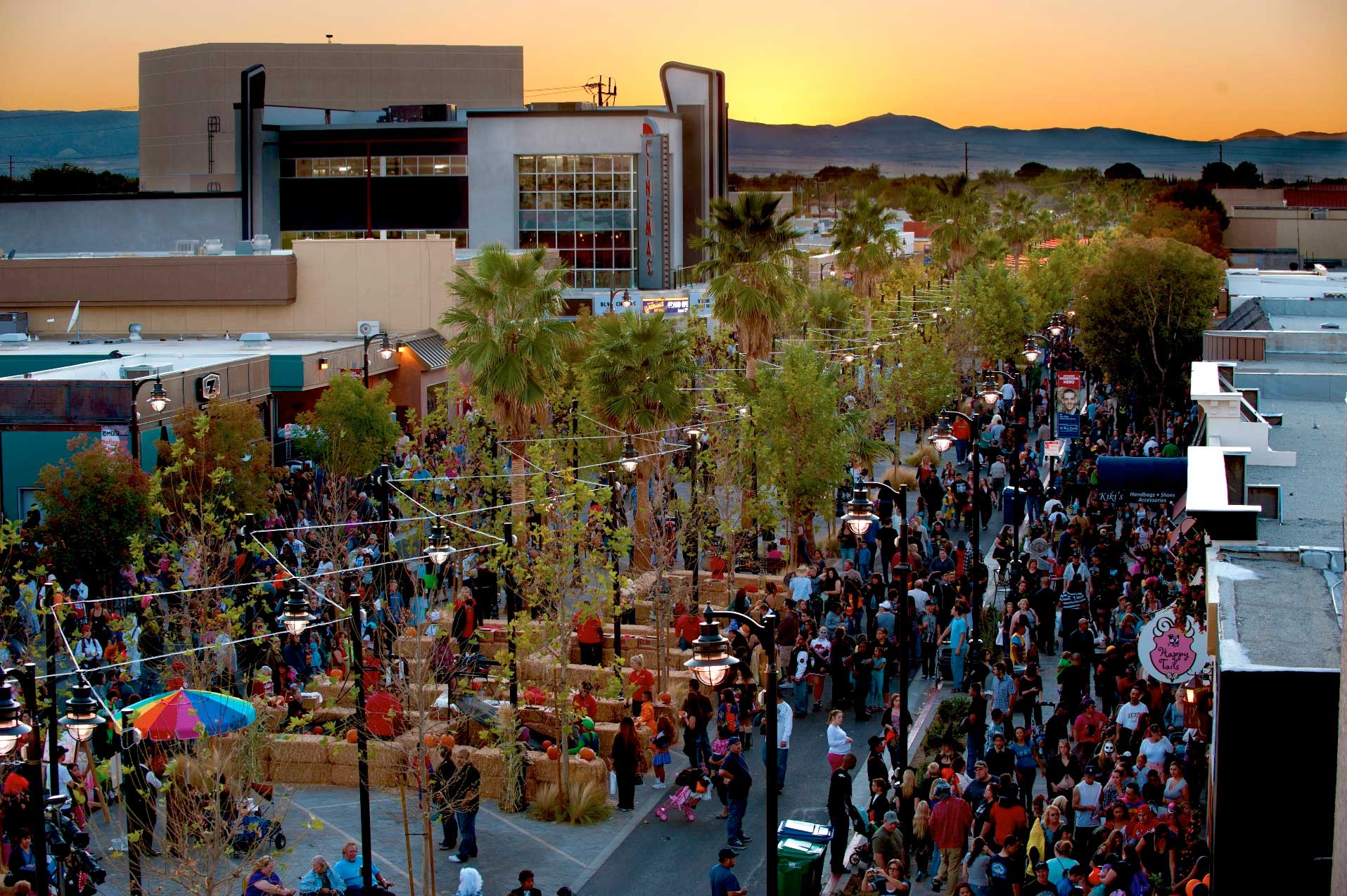
Prior to the project, Lancaster prepared a plan for increased congestion based on anticipated development. “The City has instituted two mitigation measures, restricting left turns from northbound Fig Street (by making it one way only) and by not providing an opening through the Ramblas at Genoa Street. However, these mitigation measures were for a traffic forecast for 2030, which assumed fairly dense buildout of the downtown,” says Dow. The city is monitoring traffic flow and will consider more changes if necessary.
Lessons Learned
Perhaps the greatest lesson of the BLVD is that “the design of the street actually affects how people behave. That’s such a deeply important concept that we are taking it into other areas of the community,” Ludicke says. “In our community, people don’t stop for pedestrians in crosswalks. On the BLVD, they stop. Rarely do I see people not stop when I need to cross.”
The city is implementing more pedestrian improvements in and around downtown, including a road diet of 1.5 miles of Lancaster Boulevard to the west of the BLVD—which will reduce the travel lanes on the thoroughfare to two, from four, and provide on-street parking.
Although the Ramblas was built nearly exactly as designed, other planned elements were not built due to budget constraints. The original design included full-size roundabouts at the east and west gateways to the BLVD, which were dropped due to budget constraints—but the city may revisit building them in the future, Ludicke says.
With the exception of the removed signals, the intersections have not changed much—curb return radii stayed approximately 15 feet. Curb ramps are provided at the crosswalks for accessibility. Bollards mark the ends of the Ramblas on each block. Vehicles crossing the BLVD must stop at stop signs, and yield signs and markings are provided in the median for left-turns onto the BLVD, but vehicles traveling east and west along the BLVD have no signs or signals on this nine-block stretch. “The design of the street is supposed to influence behavior, and that was a wise decision, because people have gotten used to driving on the BLVD,” says Ludicke.
While a significant number of housing units have been built, the vast majority are currently low- and moderate-income restricted,” Dow explains. “We would like to see more diverse housing types available, including some market-rate options such as condos. As our housing market continues to gain strength, these types of projects are beginning to become more attractive financially.”
When it came to transforming the city’s main street, Lancaster refused to compromise on essential aspects of a strong design—and the results speak for themselves, says Caudle. Says Bharne: “Every city should be doing one ‘Lancaster’ over the next decade—why should they not?”




